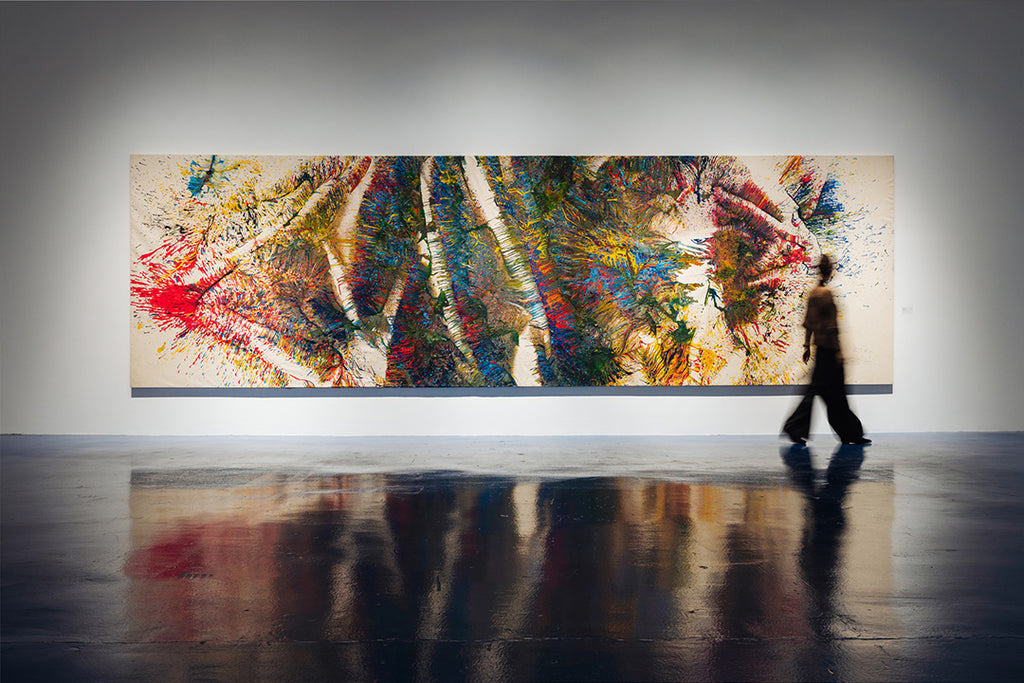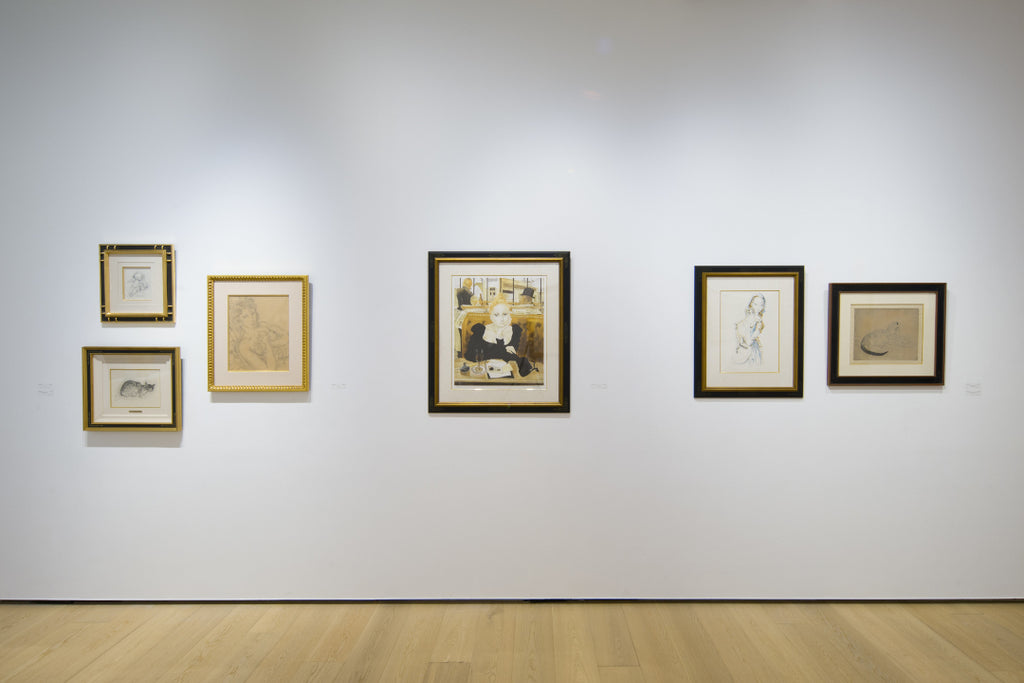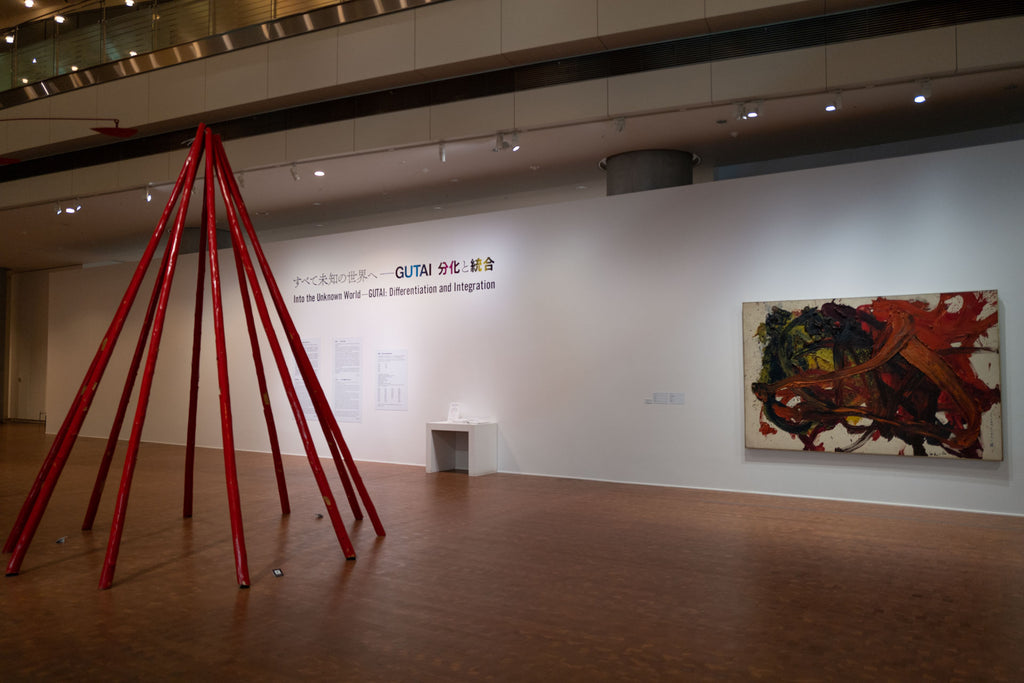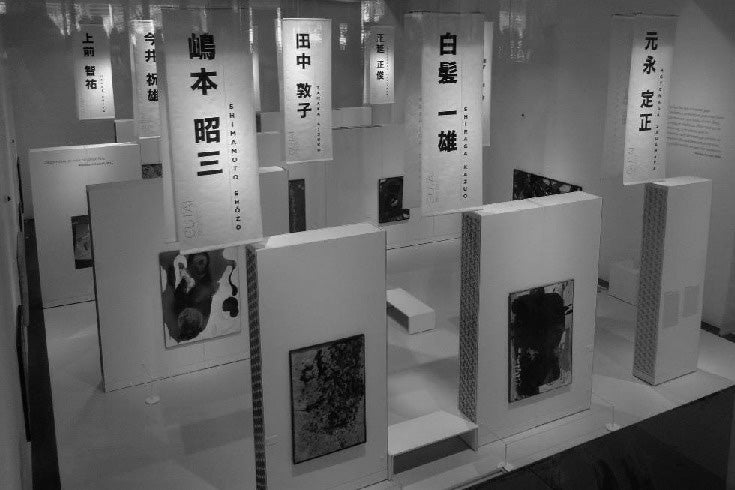ARTICLES
50 Years Since the End | The Gutai Art Association Revives at the Nakanoshima Museum of Art, Osaka
December 27, 2022
ART NEWS

"Into the Unknown World – GUTAI: Differentiation and Integration" exhibition installation view, Nakanoshima Museum of Art, Osaka
The Gutai Art Association was an avant-garde artist group that left an indelible mark in the postwar art history of Japan. To commemorate 50 years since the group's dissolution, a retrospective exhibition entitled "Into the Unknown World – GUTAI: Differentiation and Integration" is being held at Nakanoshima in Osaka, which used to be a base for Gutai's activities. It is a joint exhibition held simultaneously at two museums that stand side by side. Here we introduce the exhibition presented at the Nakanoshima Museum of Art, Osaka.
Differentiating GUTAI at the Nakanoshima Museum of Art, Osaka

Exterior view of the Nakanoshima Museum of Art, Osaka with Kenji Yanobe's "SHIP'S CAT (Muse)" in the foreground and ad balloons for the recreation of the International Sky Festival (1960) floating from the rooftop.
"Into the Unknown World – GUTAI: Differentiation and Integration" is a rare kind of exhibition held simultaneously at two venues. Presented under the two themes of "differentiation" and "integration", the exhibition seeks to create a new understanding of the art of Gutai.
The Nakanoshima Museum of Art, Osaka focuses on "differentiation" and explores the truth behind Gutai by presenting the exhibition in four different sections, each with its own keyword: "Space", "Material", "Concept", and "Place". Through each work of art, it reveals how Gutai's avant-garde expressions came about, and how each individual artist was received by the group.
Artworks that Encroach into "Space"
Chapter 1 "Space" explores how Gutai's artworks influence the space around them. It features some large works of art that dominate the gallery space, by artists like Jiro Yoshihara, Atsuko Tanaka, Saburo Murakami, Shozo Shimamoto, Shuji Mukai, Yuko Nasaka, and Sadamasa Motonaga.
One particularly prominent artwork is a three-dimensional piece that is also depicted in a tableau painting. It is Michio Yoshihara's "Work" reproduced for this exhibition, which resembles a waterfall made of countless strips of colorful paper tape hanging from a wall. Another unique and unforgettable piece is Atsuko Tanaka's "Electric Dress", which fills the entire room with vibrant colors when lit. It has garnered attention for its innovative idea and eccentric appearance since it was first shown to the world.
Every now and then in the exhibition room, you can hear the loud ringing of a bell. Many visitors stare at the ceiling in confusion, perhaps unused to hearing such a sound in an art museum. The source of the sound is Atsuko Tanaka's "Work (Bell)", which rings in succession when a switch is pressed near the room's entrance.

Left foreground: Atsuko Tanaka's "Work" (1961). Right background: Michio Yoshihara's "Work" (1965/2022). ©Kanayama Akira and Tanaka Atsuko Association

Installation view of Atsuko Tanaka's "Electric Dress" (1956/1986), Takamatsu Art Museum. It is lit up only at certain hours to help preserve the artwork. ©Kanayama Akira and Tanaka Atsuko Association

Left to right: Jiro Yoshihara's "Work (White Circle on Black)" (1967). Norio Imai's "White Ceremony HOLES #5" (1966). Senkichiro Nasaka's "Work" (c.1970), The Miyagi Museum of Art.
"Materials" that Tell a Story
One of the most important aspects of Gutai art was its use of new and unique materials. Chapter 2 "Material" unravels how each Gutai artist approached the use of different materials.
Jiro Yoshihara made the following declaration in the Gutai Art Manifesto: Gutai art does not transform material but brings it to life. Gutai art does not falsify the material. In Gutai art, the human spirit and the material shake hands with each other, even though they are in opposition.
Just as these words indicate, the art of Gutai includes paintings that utilize paint in new ways, as well as innovative works that make use of materials such as cloth, glass, sand, resin, and vinyl adhesive.
Some of Gutai's unique approaches include the tarashikomi-inspired dripping method of Sadamasa Motonaga, who became a children's book illustrator in his later years. There is also Shozo Shimamoto's novel technique of throwing paint-filled glass bottles onto a canvas. Such works that directly challenge the way paint is used are prominently displayed in the "Material" exhibition room.

Installation view of the exhibition's Chapter 2 "Material"

Left to right: Sadamasa Motonaga's "Work" (1962), Museum of Contemporary Art Tokyo. Jiro Yoshihara's "Work" (1960), Ashiya City Museum of Art & History. Shozo Shimamoto's "1962-1" (1962).

Installation view of Michio Yoshihara's "Work" (1956/93)
The "Concept" Hidden Behind the Artworks
Chapter 3 "Concept" features the works of Kazuo Shiraga, Saburo Murakami, and other prominent Gutai members.
Kazuo Shiraga applied paint to a canvas on the floor by sliding his bare feet while holding onto a rope suspended from the ceiling. Saburo Murakami introduced the element of time in his works by creating paintings that naturally peeled off with time. Akira Kanayama devised an automatic method of creating paintings by using remote-controlled cars. After being criticized that her works lacked substance, Tsuruko Yamazaki embraced the idea of emptiness through a work made with tinplate and lights. Such artworks and their concept explained in the artists' own words are displayed in the "Concept" exhibition room.

Center: Saburo Murakami's "Air" (1956/94), private collection ©MURAKAMI Tomohiko. Background: Various works of Akira Kanayama ©Kanayama Akira and Tanaka Atsuko Association.

Installation view of Kazuo Shiraga's "Work (Red Timber)" (1957), Museum of Contemporary Art Tokyo, with the same artist's canvas paintings in the background.

Exhibition installation view. Far right: Tsuruko Yamazaki's "Work" (1964), Ashiya City Museum of Art & History
The "Place" where Artworks and Space Intersect
Gutai was also unconventional in terms of the places where they exhibited their works. Besides holding exhibitions in the Gutai Pinacotheca museum and other indoor venues, they also presented their works outdoors or onstage, such as during their events called "Outdoor Modern Art Experiment in the Midsummer Sun" and "Gutai Art on the Stage".
For this exhibition, Saburo Murakami's "All Landscapes", which features an empty wooden frame, is displayed at both the Nakanoshima Museum of Art, Osaka and the National Museum of Art, Osaka. Depending on the specific place, time, and viewing angle, visitors can see various "landscapes" cut out by the frames.

Installation view of Saburo Murakami's "All Landscapes" (1956/93), private collection ©MURAKAMI Tomohiko
Some of the artworks are reproductions made especially for this exhibition, such as Sadamasa Motonaga's "Work (Water)" suspended from the ceiling near the museum's entrance, Toshio Yoshida's "FOAM-A", a piece that uses foam as an artistic medium. There is also a reproduction of Shuji Mukai's "Restroom with Nonsense Symbols" which covers the museum's entire restroom with strange symbols. The exhibition even recreates Gutai's "International Sky Festival" which features paintings hung on balloons floating in the air. These reproductions and new installations give the exhibition a timely feel for Gutai art in Nakanoshima in 2022.

Sadamasa Motonaga's "Work (Water)" (1955/2022), reproduced for this exhibition.

Shuji Mukai's "Avatar 1, 2, 3, 4, 5" (2022). These five avatars are covered in nonsense symbols and appear throughout the museum.
50 years after the group's dissolution, "Into the Unknown World – GUTAI: Differentiation and Integration" revives the art of Gutai in Nakanoshima. The exhibition ended on January 9th.

Nakanoshima Museum of Art, Osaka
"Into the Unknown World – GUTAI: Differentiation and Integration"
Nakanoshima Museum of Art, Osaka / The National Museum of Art, Osaka
Period: October 22, 2022 (Sat) – January 9, 2023 (Mon)
Opening hours: 10:00–17:00 (10:00–20:00 on Fridays and Saturdays at the National Museum of Art, Osaka)
*Last entry 30 minutes before closing
Closed: Mondays (except January 9)
*Nakanoshima Museum of Art, Osaka closed from December 31 (Sat) to January 1 (Sun), open on January 2 (Mon)
*The National Museum of Art, Osaka closed from December 28 (Wed) to January 3 (Tue)
Venue: Nakanoshima Museum of Art, Osaka 5F Galleries / The National Museum of Art, Osaka B2F Gallery



